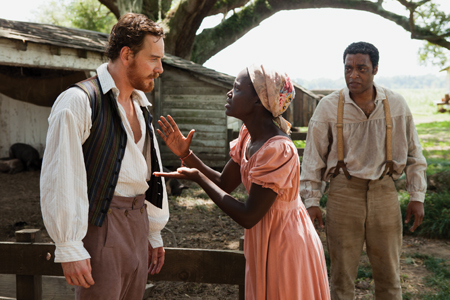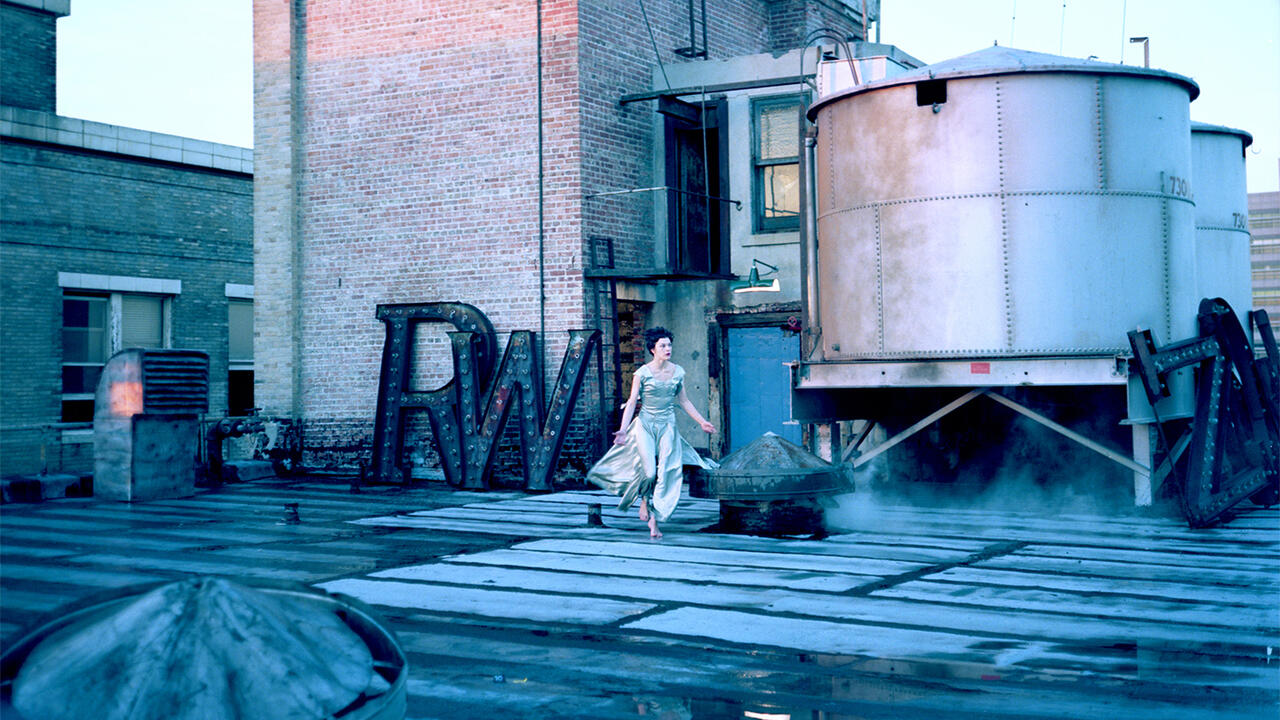Histories of Violence
Has 12 Years a Slave finally exorcised Hollywood’s racist legacy? A consideration of representations of slavery on screen from The Birth of a Nation to Django Unchained and Belle
Has 12 Years a Slave finally exorcised Hollywood’s racist legacy? A consideration of representations of slavery on screen from The Birth of a Nation to Django Unchained and Belle

In Discipline and Punish (1975), Michel Foucault wrote that, at the beginning of the 19th century, ‘the great spectacle of physical punishment disappeared; the tortured body was avoided’. He was mistaken.
While European streets may have teemed with enlightened flâneurs staring into shop windows rather than at quartered corpses, the practice of torture still existed; it was just exported to the colonies. In America, particularly in the South, torture wasn’t something that took place elsewhere. Instead, it flourished as a domestic method for keeping imported Africans, as well as born and (literally) bred African Americans, subjugated in the country’s system of ‘involuntary labour’: slavery.

In fact, this period offers a unique example of the conflation of Foucault’s two penal styles. We know that the publicly hanged, whipped, maimed, branded and shackled black slave body was used to display the supremacy of whites, just as the quartered body of the regicide Robert-François Damiens, Foucault’s subject of study, proved the sovereignty of the French crown. But the project of slavery in the US went further. By marshalling tools such as law, engineering, literature, medicine, economics, news media etc., it provided a comprehensive testing-ground for methodologies of oppression, myth-making and propaganda. While Foucault’s ostensibly French history failed to make the link between slavery and the consolidation of biopower via disciplinary control, the same excuse of geographical bias cannot be offered up for cinematic depictions of US slavery, made in US and funded by US dollars, even when they are helmed by British directors.
Instead of tackling the complexity of a fully rationalized system, used to regulate human bodies for maximum profitability even after emancipation in 1865, slavery on film has continually deployed the spectacular image for maximum visual impact and emotional response. It has evolved in its 100-plus-year history, beginning with Edwin S. Porter’s 1903 version of Uncle Tom’s Cabin, the first of at least nine known adaptations of Harriet Beecher Stowe’s 1852 novel to be made during the silent era, from propagandistic depictions of racial stereotypes to the rehearsal of standard character tropes and dramatic situations that play out on the Southern plantation. What distinguishes postwar films that deal with slavery – such as Slaves (1969), Goodbye Uncle Tom (1971), Amistad (1997) and Beloved (1998) – from those produced during Hollywood’s overtly racist, early 20th-century heyday, is a commitment to realism, itself now measured in terms of how accurately brutality, despair and desolation are depicted and elicit visceral responses. The question is: are exercises in mass catharsis enough to purge Hollywood’s racist past? More importantly, does catharsis misdirect public ire and empathy towards a historically distant location and people – i.e. the South and antebellum-era slaves? And has this distraction stopped the true scope of slavery from being confronted today? The answer lies in the story of its cinematic evolution.
The history of slavery on film can be split into two periods: pre- and post-civil rights. If the depiction of African Americans as servile, imbecilic subhumans became untenable in the 1960s, the first half of the century, with its nationwide enshrinement of inequality in the law of segregation, created an atmosphere in which the dehumanization of blacks on film was seen as a natural extension of societal order. In this respect, the paradigmatic pre-civil rights slavery film is a work that will celebrate its centenary next year: D.W. Griffith’s three-hour silent epic, The Birth of a Nation (1915).

Presented as an objective history of the South – President Woodrow Wilson is said to have declared at a screening at the White House, ‘It’s like writing history with lightning’ – Griffith’s film is pure propaganda, couched in historical fantasy and outright lies. The tale of an Old South family, whose ‘genteel’ life surrounded by happy servants and slaves is suddenly overturned by civil war and power-hungry, emancipated blacks from the North, is an elaborate piece of advertising. Originally titled The Clansman, it was designed to promote the Ku Klux Klan as, according to one of the film’s intertitles, ‘the organization that saved the south from the anarchy of black rule’. Indeed, at the end of the picture, hooded white supremacists ride heroically into town to drive out marauding negroes and ethnically cleanse the South. Despite, or perhaps because of, its spectacular and extremely affecting technical innovations, The Birth of a Nation was decried then – as now – as racist, ideologically retrograde cinema. In fact, black film producer Emmett J. Scott released The Birth of a Race in 1918, billed as a cinematic retort dedicated to ‘all of the races of the world’, while the contrite Griffith, perhaps worried about how adverse public reactions would effect the marketability of future work, released his own denunciation of persecution with Intolerance (1916). Still, the stereotypes that The Birth of a Nation shaped – alongside pioneering filmmaking techniques such as the close-up, the split-screen shot, cross-cutting – endure. According to the American film historian Donald Bogle, in his book Toms, Coons, Mullatoes, Mammies and Bucks (1973), ‘one can detect in this single film the trends and sentiments that were to run through almost every black film made for a long time afterward’.
Griffith’s depictions of African American character essentially produced the five reductive archetypes listed in Bogle’s title: Uncle Toms, simple and faithful slaves who put their masters before themselves; coons, treacherous and unintelligent slaves who would betray anyone for the right price; mulattoes, ambitious slaves whose mixed blood damns them to a tragic liminal life of being neither white nor black enough; mammies, housebound and overweight black cooks, whose love for their masters and mistresses allow for a kind of surrogate matriarchy; and bucks, powerful black males who, due to the repression of sexual drives and the daily emasculations suffered in slavery, are lascivious rapists-in-waiting. Each of these characterizations were rigidly adhered to in pre-civil rights Hollywood film; they were the only roles open to African American actors who wished to appear on the silver screen.
Of these five types, the mammy and the buck proved most mutable and reusable, precisely because they could be made to incorporate other racist personas. Pre-civil rights, the mammy dominated. Most notably in the Civil War epic Gone with the Wind (1939), in which Hattie McDaniel plays the O’Hara family’s faithful and happy servant, who can speak a gossipy truth to the power of Vivien Leigh’s Scarlett. However, it was the buck who fully traversed the 1960s divide to re-emerge as the hypermasculine focus of slavesploitation films like The Legend of Nigger Charley (1972) and the Dino De Laurentiis-produced Mandingo (1975) and Drum (1976), as well as the post-Civil War cowboy movie Joshua (1976).

In the great cinematic dichotomy that pits blackness as the eternal ‘other’ against which whiteness is defined, the buck body, in the simplified symbolic order of Hollywood film, became a site onto which white male society projected post-emancipation fears of reprisal (the angry negro seeking to overthrow and enslave whites) and repressed sexual desires (the would-be rapist of white women). Quentin Tarantino’s risible Django Unchained (2012), as a spectacle of pure slavesploitation pastiche, resurrected the badass buck using parody as an alibi. However, a threadbare narrative and shoddy script couldn’t shore up the film’s eventual collapse into a prolonged display of comic-book violence.
In some ways, Steve McQueen’s 12 Years a Slave (2013) has swept away Griffith’s legacy. However, while his dignified, naturalistic and human African American characters finally present audiences with a repudiation of earlier racist typologies, the film stops short of exposing slavery as a core part of the engine through which American independence, liberty and modernity was achieved. This is due in part to the narrative limitations set by adapting the film from the book of the same name. In his 1853 text, Solomon Northup gives a true account of his life as a freeman of the North who is kidnapped and transported to the South, where he is sold into slavery, before being liberated and finally returned to his family. Northup’s story – like those of Frederick Douglass, Josiah Henson and Henry ‘Box’ Brown – is one of the few American narratives written by a former slave, which was published and well received in the 19th century. All were laudable projects that, like McQueen’s film, stopped short of indicting American society in order to present an image of black masculinity as, according to bell hooks, ‘one of hardworking men who longed to assume full patriarchal responsibility for families and kin’.

But 12 Years a Slave, McQueen’s third and most ambitious feature film, is also an incontrovertible product of his favoured directorial and editorial strategy of zeroing-in on the body. He first developed this as an artist in the strikingly realized 16mm film Bear (1993), in which two naked black men wrestle in darkness, using an ambiguous register to problematize normative considerations of race, homoeroticism, masculinity and violence. It stands as a defining statement of intent. The male body as a site upon which themes of oppression, alienation, emasculation and abuse can be projected is central to McQueen’s powerful first two films, Hunger (2008) and Shame (2011). Something else that has been carried over from McQueen’s earlier art films is his tendency to clip away biographical details: how central characters came to be themselves, and how they or their legacies endured after the events on film, are treated as so much unnecessary contextual material. This worked well as a way to explore the psychodramatic territories of a single struggle, as in the hunger strike in Hunger and an existential crisis caused by sex addiction in Shame. In 12 Years a Slave, however, attention to contextual material would have avoided both the trap of historicized distance and the essential restaging and re-presentation of familiar plantation drama conventions, made contemporary by a new realism of brutality.
To put it another way: we all know what happens once action moves to a plantation in a film about slavery. Sadism, brutality, sexual perversion, innocence, stoicism and the metaphysics of hope are all enacted and embodied by characters across what feels to be one long set piece in the sun. What we do not know, and what has never been seriously considered on film, is how free black men lived in America during slavery. The complexity of this situation is given short shrift by McQueen’s impatiently directed expository scenes in which Northup wanders around an idealized North, blithely unaware of racism. And in choosing not to film beyond Northup’s family reunion, we do not see how his struggle with modernity’s ‘rational’ forces of oppression – bureaucracy and the law – came to nothing. In life, after losing a legal battle to have his kidnappers prosecuted, Northup disappeared during a tour of anti-slavery lectures. His eventual fate remains unknown, but while depression may have led to suicide, another kidnapping isn’t unlikely. Whatever the case, it is clear that shortening the plantation scenes and extending the film to Northup’s disappearance would have brought the narrative into the North and the roots of metropolitan racism that insidiously pervade disciplinary institutions today.

On the eve of The Birth of a Nation’s centenary, 12 Years a Slave – which by winning Best Picture at the 2014 Oscars has had its status as a 21st-century classic officially sealed – can almost be regarded as a final and bloody exorcism of Griffith’s racist legacy. But although the presentation of stereotypes in drama may now be unthinkable, the veil of satire, comedy and parody allows aspects of Griffith’s character types still to appear on the big screen, television and online, whilst nationalists and the tabloids deploy them to stoke fear and moral panic, and well as to denigrate. Despite its technical brilliance, assured pacing and strikingly naturalistic performances from Chiwetel Ejiofor and Lupita Nyong’o (who won the Oscar for Best Supporting Actress) McQueen’s narrative presents us with yet another image of slavery as man’s impassioned, evil and delirious inhumanity to man, rather than a rational form of torture devised by supposedly enlightened minds. Perhaps the reductive and spectacular demands of Hollywood cinema may never be up to that task. But, almost 150 years after abolition, McQueen’s commanding project, and his remarkable achievement as an artist-turned-director, have cleared the way for a film that will reveal slavery as a thorough system of objectification and dehumanization, and the foundation upon which modernity was built.
This month, the baton and the burden will pass to British director Amma Assante, as her film Belle (2013) is set for release. Based on the true story of Dido Elizabeth Belle, a mixed-raced child raised in late 18th century Britain by her reluctant and racist aristocratic family, Assante’s picture sets up a situation in which ‘the other’ steps out of the colonial imagination into the mannered unreality of British high society. Whether Belle will transcend the ruffled trappings of costume drama to make a wider point about imperialism and Britain’s role in the slave trade remains to be seen.
In 2014, 12 Years a Slave was awarded Oscars for Best Picture, Best Supporting Actress and Best Adapted Screenplay at the Academy Awards; the Golden Globe for Best Motion Picture (Drama); and Best Film and Best Actor awards at the British Academy of Film and Television Arts. Belle will be released in the USA this month, and in the UK in June.






















